Research
Deep bed farming is an innovative new form of Malawian-led climate-smart agriculture. Over the past 20 years, Tiyeni's Malawi team has successfully refined the components of deep bed farming to make it widely applicable across Malawi, with the potential to spread across sub-Saharan Africa.
DBF is a hybrid form of Conservation Agriculture (CA) a well established (and successful) set of methods which involve minimal soil disturbance, cover crops and crop rotation. Over several years of trial and error Tiyeni has developed new innovations to build on the CA approach, notably by breaking up the hardpan and on the particular design of the deep beds.
This page contains research reports on DBF from our internal research, universities, and independent external researchers.
In Malawi we partner with institutions including Mzuzu University, Lilongwe University of Agriculture and Natural Resources (LUNAR), University of Livingstonia, the Japan International Cooperation Agency (JICA) and DARS - Department of Agricultural Research Services.
More research is needed on DBF, however, to discover more about what works, how it works, and how the technical aspects of DBF fit (or don't fit) with the sociological, cultural and political background of the places where it is practiced.
At the bottom of the page we outline a number of potential avenues for researchers. We warmly invite them to come to Malawi and investigate what is happening.
Malawian Government approval
The Agriculture Technology Clearing Committee (ATCC), December 2021
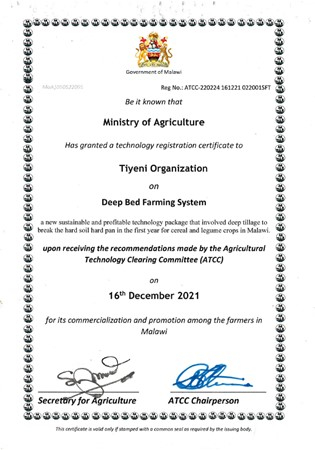
Following 3 years of trials, the Malawi Government has approved Tiyeni’s Deep Bed Farming (DBF) as a successful and profitable technology to be adopted and promoted by Government field officers. Already, national newspapers national radio and national television have featured DBF, which has served to spread knowledge of the successes of the DBF technology.
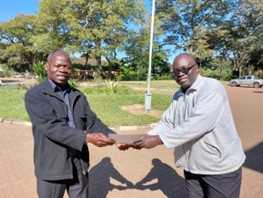
The Agriculture Technology Clearing Committee (ATCC) of the Government of Malawi voted unanimously in favour of the Deep Bed Farming system. The research by Department of Agricultural Research Services (DARS) found that Deep Bed Farming out-performed all other methods tested in terms of increased maize yields of more than double in the first year of implementation and improving the soil’s physical parameters including by enhancing moisture retention.
This was a huge milestone for Tiyeni Malawi and its DBF technology, best known for its control of soil erosion, water harvesting, and dramatic increase in crop yields, alongside its nature and climate friendliness.
DARS Technical Report on Deep Bed Farming
Independent evaluation of Deep Bed Farming in Emsizini Hotspot
Kabash Consultants, June 2023.
A new independent report details impressive results and benefits gained for farmers using Deep Bed farming in the Emsizini Hotspot area over 2021 to 2023. The full report and key impacts can be read below:
STRENGTHENING SMALLHOLDER FARMER RESILIENCE, RESPONDING TO COVID-19 AND ELIMINATING FOOD POVERTY
Maize yield before and after Deep Bed Farming:
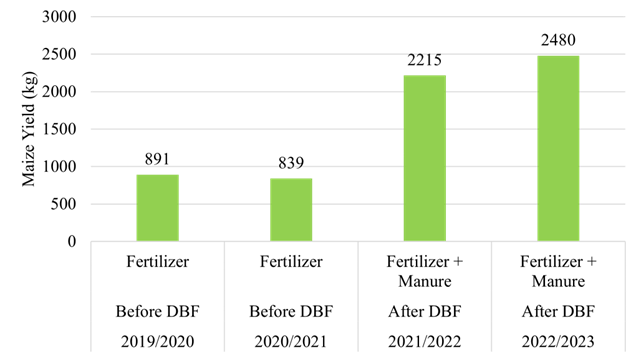
Increased income arising from improved production:
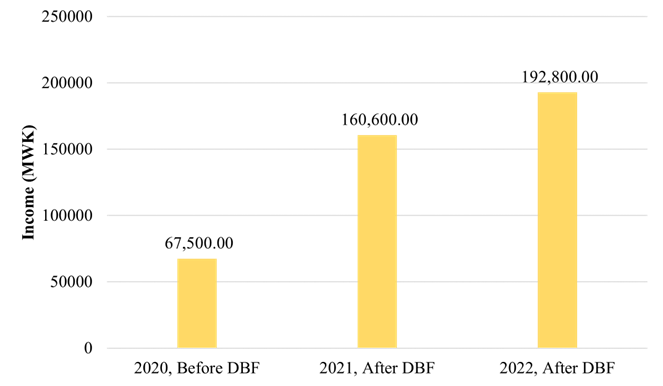
With thanks to the Halcrow Foundation for funding this piece of research.
Yield data
Deep Bed Farming (DBF), a climate smart agricultural method, has been tested by farmers to replace conventional ridge farming. It increases maize yield from an average of 1.7 tonnes per hectare to over 8.0 tonnes per hectare. Here is 2022 maize yield data from our southern hotspot:
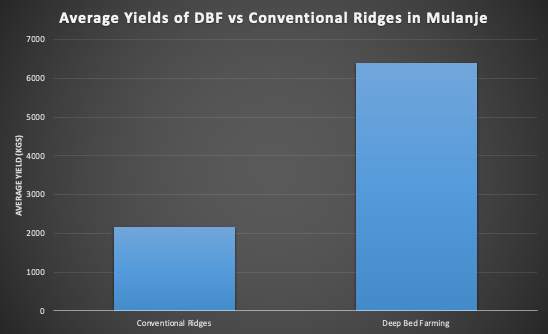
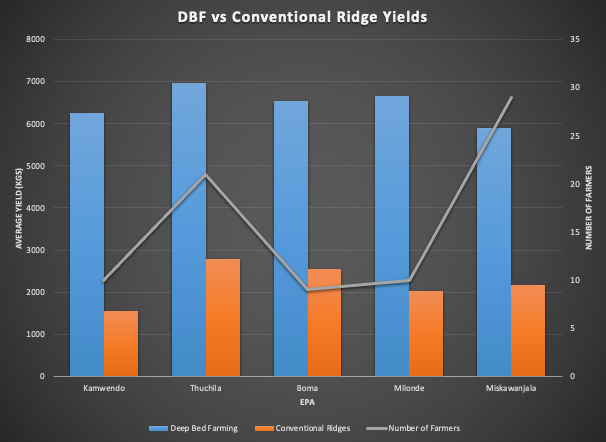
Where maize is grown with other crops through intercropping, DBF increases both the maize yield and the other crops. Our latest internal research reports are shown here:
2022 Pigeon pea yield increases
The social-ecological sustainability of the Tiyeni deep-bed conservation agriculture system in Malawi
Mvula, Albert (2021) The social-ecological sustainability of the Tiyeni deep-bed conservation agriculture system in Malawi. PhD thesis, University of Worcester.
Dr Albert Mvula recently published the results of his three-year PhD research on the ‘Social-ecological sustainability of the Tiyeni deep bed farming system in Malawi’. Albert’s Director of Studies at the University of Worcester, Dr Alan Dixon, tells us more in an overview below.
An overview of Albert’s Mvula’s recently published PhD research
Independent evaluation of Deep Bed Farming in Manyamula
Kabash Consultants, September 2021.
A new independent report details impressive results and benefits gained for farmers using Deep Bed farming in Manyamula. The Impact Survey assessed the impact made by the project since November 2018 towards achieving the goal of contributing "to transform small-scale farming through productivity and food security gains." The full report and key impacts can be read here.
The data revealed a big increase in ground nut yields after the adoption of Deep Bed farming. The average is a 125 per cent rise in nut yields.
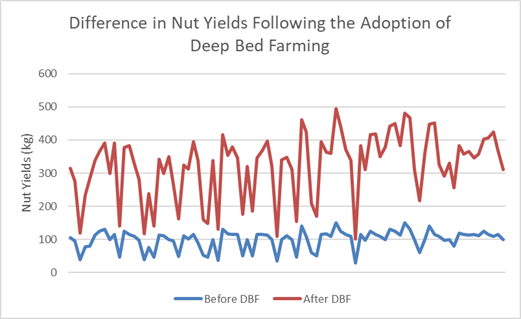
Profitability of Deep Bed Farming versus conventional ridge methods
France Gondwe, June 2020.
This survey group of 346 farmers in 14 groups in Malawi's North and Central regions once again found a doubling of yields for farmers who adopted Deep Bed Farming (DBF,) and a steady increase in adoption from 2017 to 2019. However, when profitability was calculated -- a simple calculation of revenues minus costs -- the results were more spectacular.
For conventional ridge farming, only some of the areas showed any profit at all, while some showed monetary losses. On average, profits were MK 49,000 per hectare per year.
For Deep Bed Farming, however, profitability in the first year was MK427,000 per hectare per year on average, nearly nine times as much as the average for conventional ridge methods.
However, DBF involves a lot of intensive (and expensive) manual labour in Year 1, as the hardpan is broken and the Deep Beds built, but once the Deep Beds are in place the costs are significantly lower than with conventional ridge methods. So if the (lower) average five year projected costs are considered, profitability rises to 624,000 MK per hectare, over 12 times as much as conventional methods.
[2018 baseline report (below) and adding new survey results, this short preliminary study shows i) exponential growth rates of the adotion of DBF as farmers see and emulate their neighbours' successes; ii) abandonment rates of just three percent during project implementation; and iii) retention rates of 55 percent after the departure of Tiyeni field extension officers and inputs, significantly higher than for other farming technologies. How Many Farmers are Retaining Deep Bed Farming?](2018 baseline report](A Rapid Field-based Livelihoods Analysis of Tiyeni Activities)
Food insecurity, crop yields and Deep Bed Farming in Malawi
France Gondwe, May 2020.
A study of the impact of Deep Bed Farming (DBF) on hunger among 560 Malawian farmers. Results include:
- Families using Deep Bed Farming (DBF) consume an extra meal per day compared to farmers growing crops conventionally.
- We found an average 146 percent rise in crop yields in 2018/19 – that is, yields were roughly two and a half times what they were before adoption of DBF.
- All farming families in the group eradicated severe food insecurity within six years.
.
Long term sustainability of Deep Bed Farming
France Mzotah Gondwe, Tiyeni, April 2020
Many projects to promote new farming technologies in different countries show high adoption and retention rates during the monitoring phase while projects continue to provide extension support, inputs and incentives. However, retention rates often fall sharply after the projects come to an end and the inputs and support dry up.
Drawing on the 2018 baseline report (below) and adding new survey results, this short preliminary study shows i) exponential growth rates of the adotion of DBF as farmers see and emulate their neighbours' successes; ii) abandonment rates of just three percent during project implementation; and iii) retention rates of 55 percent after the departure of Tiyeni field extension officers and inputs, significantly higher than for other farming technologies. How Many Farmers are Retaining Deep Bed Farming?
Farmer experiences of Tiyeni’s ‘deep-bed farming’ system in Malawi
Albert Mvula and Alan Dixon, University of Worcester, 2020
A study of 111 farmers adopting DBF via a field survey in 2017. Highlights
- "Results suggest positive experiences among most Tiyeni farmers characterised by significant increases in crop yield and the wider spontaneous adoption of DBF throughout northern Malawi.
- 90 percent of farmers adopting DBF reported a doubling of yields compared to the use of traditional ridge methods; 10 percent reported a tripling of yields.
- Motivations for adopting DBF varied: 87 percent said high crop yields were a key factor; while 43 percent said its cheap cost (chemical fertilisers replaced with organic fertilisers like manure) were a key attraction. Only five percent cited inputs from Tiyeni as a factor in adoption.
- The heavy labour associated with breaking up the hard pan in the first year was a significant negative factor
This table highlights the enthusiastic response, as farmers start with a conservative approach, only allocating a small part of their land to Tiyeni methods, then expand.
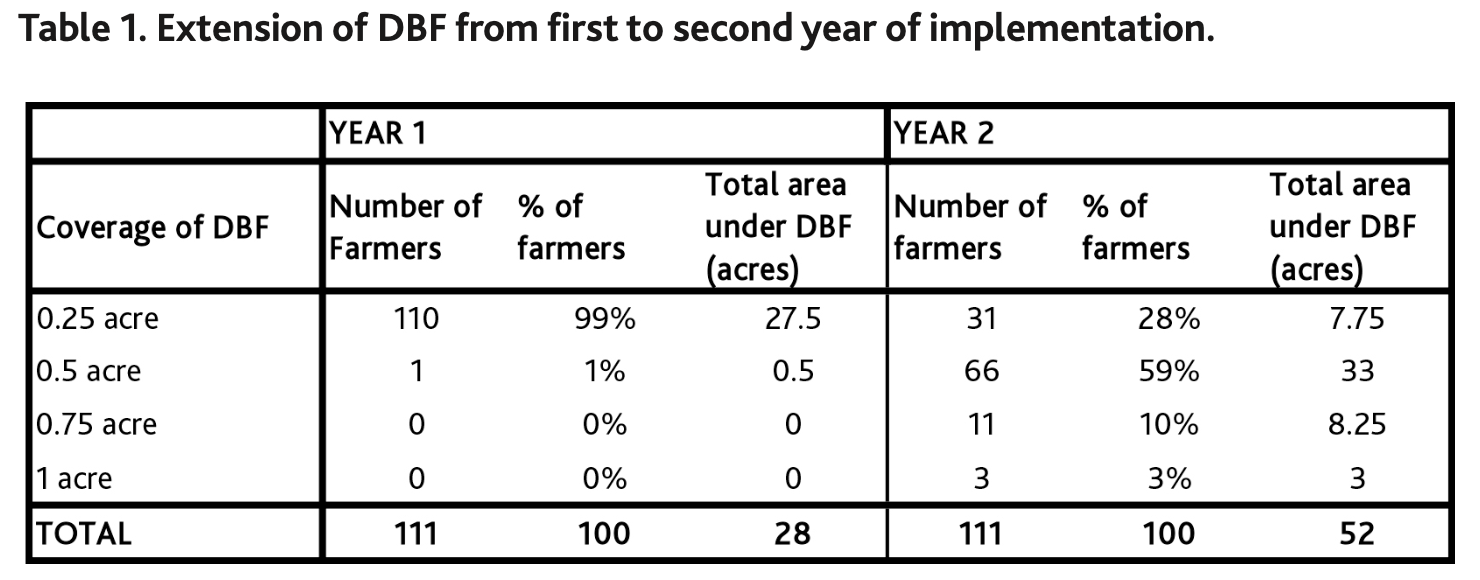
[2018 baseline report](undefined)
Report on Evaluation of Deep Bed Farming System in Malawi
Malawi Department of Agricultural Research Services (DARS,) Sept 2019.
An official Malawi government assessment of Deep Bed Farming, using a randomised complete block design with split plots. Deep Bed Farming was compared with conventional tillage, Conventional Tillage with box ridges, Pit Planting, and Deep Bed Farming.
The abstract and introduction say:
“Though farmers have increasingly demanded and adopted the Deep Bed method of farming due to its apparent superior performance even under stressful agronomic conditions such as dry spells, the technology is yet to be approved for farmers use in Malawi. An experiment, therefore, was conducted. . . . The study revealed that deep bed tillage system increased maize yield in two of the agroecologies (higher and lower altitude) for under on-station management. Conversely it increased maize yield yields in the mid agroecologies under farmers management. Maize biomass yield was also increased under Deep bed farming system compared with the pit planting system in the low altitude agroecology sites under on-station management. Legumes grain yield was increased when deep bed and conventional tillage with box ridges in all the agroecologies under on-station management. Deep bed and conventional tillage with box ridges also increased biomass yield in the mid and high altitude agroecologies. Similar to crop yield, Deep bed especially under intercropping, also increased land equivalent ratio than all the tillage systems. Soil moisture was also increased under deep bed and pit planting systems especially in the low altitude agro-ecology which is the hottest agro-ecology of the three agro-ecologies under study. In general, Deep bed farming can be a new good technology that may be promoted among farmers in Malawi as it increases both maize and biomass yields. The increased biomass production may lead to increased soil organic matter in the long run as the crop residues are laid on the soil surface.” (Our emphasis.)
A copy of the full study is available on request.
At the time of writing (April 2020), Tiyeni is hopeful that Deep Bed Farming will be approved as an official farming technology by the Malawian government.
Tiyeni 2018 Baseline Survey
Our 2018 baseline report, which interviewed 560 farmers in eight different Extension Planning Areas, provides a wealth of data. These include findings such as:
- There are more female (53%) than male farmers using DBF
- Nearly two thirds of farmers estimated that the use of DBF was increasing.
- 13.6 percent of farmers said they were willing to convert 100 percent of their land to DBF.
- DBF farming increases the yields of almost all crops that the farmers have tried including maize, common beans, soya beans, ground nuts, and sweet potato.
- DBF increased mean annual income from MK500,000 to more than MK800,000
Participatory Maize Yield Assessment
Colin Andrews, with Francis Shaxson, and Tim Jones, 2018
A 2018 study prepared by Tiyeni's Colin Andrews of 11 farmers who had agreed to prepare DBF on a plot adjacent to a plot where they continued with the traditional farming method. The tilling and planting done was identical, as well as the application of mulch and fertiliser. This was reviewed by Tim Jones, a well-known statistician. While the sample size is small, the data suggests that the DBF method yields significantly more than the Ridge method. Table one, below, is in the order of the original data.

Soil loss assessment in Malawi
UN Food and Agriculture Organisation (FAO,) 2016
A report on soil erosion in Malawi (not about Tiyeni, but highly relevant to us.)
"The average national soil loss rates in 2014 was 29 ton/ha/yr. The areas with relatively high rates were the north and some pockets in the southern region. The northern region had soil loss rates ranging between 0.4 ton/ha/yr to 39 ton/ha/yr.
. . .
The net effect is loss of agricultural productivity, increased expenditure on fertilizers (that are required to maintain the yields), and a general decline in profitability of crop production. Besides the negative impact on agriculture, soil loss also affects surface water resources through loss of water quality and quantity, increased flashfloods, and siltation of rivers and irrigation canals. There are also arguments of soil loss increasing emissions of greenhouse gasses."
Click here or here for the full report.
Tiyeni method - deep bed bio-intensive farming: Research scoping visit report
A report for the International Center for Tropical Agriculture (CIAT), by Powell Mponela and James Ellison, Nov 2015.
A report by CIAT on DBF identifying areas for further research. Preliminary conclusions were scant but include this:
"[Tiyeni has] empowered farmers to grow food on small plots and attain bumper yields in the face of declining soil fertility and moisture levels due to climate variability."
Click here for the full report.
A Rapid Field-based Livelihoods Analysis of Tiyeni Activities
Alan Dixon, Institute of Science and the Environment, University of Worcester, 2015.
This contains a number of testimonials from farmers, and some preliminary conclusions, including:
- Do Tiyeni beneficiaries have more income? Yes, in some (but not all) cases.
- Do Tiyeni beneficiaries experience increased well-being? Yes, to some extent.
- Do Tiyeni beneficiaries experience reduced vulnerability? Yes, to some extent.
- Do Tiyeni beneficiaries experience improved food security? Yes. Without doubt there is strong evidence to suggest that Tiyeni farmers are able to grow more food as a result of the success of Tiyeni’s extension practices. This is not to say that they do not continue to experience intermittent food shortages, but rather that they are significantly less vulnerable to food insecurity than would otherwise be the case in the absence of Tiyeni practices. It is this success that has precipitated the demand for Tiyeni throughout the area.
"In summary, the evidence to date suggests that Tiyeni activities are having a significant impact on the livelihoods of their beneficiaries. . . there is little doubt that Tiyeni is making a key contribution towards this through its modest implementation activities which contribute to social, economic and environmental well-being, while building resilience and adaptive capacity."
Further research
Deep Bed Farming has been very effective, but (of course!) it does not work 100 percent of the time. Some farmers have abandoned it, for a variety of reasons: including:
- difficulties breaking up the hard pan (which can be incredibly hard;)
- community tensions arising from some farmers doing better than others;
- official extension workers insisting on using only approved technologies;
- farmers adopting Tiyeni for the wrong reasons such as expectations of inputs/handouts;
- some soil types (such as very sandy soils or very wet lands) not needing de-compaction;
- disease or pests damaging yields;
- failure to follow gold standard guidance and finding disappointing results.
- farmers without recourse to other income sources tend to be conservative, and may feel more comfortable with practices they have used for years.
So we could imagine any number of further research projects, investigating the strengths and weaknesses of DBF and how to improve and adapt the method for local conditions, such as:
- What kinds of soils are most subject to compaction, and could benefit most from DBF?
- Where are these soils? In which parts of Malawi? In which other countries? In which climatic zones?
- What kinds of socio-cultural and farming practices currently exist in places where DBF might be appropriate, and how can DBF be adapted or made compatible with local needs and cultures?
- What are the biological process that happen under the soil, that contribute to DBF's successes?
- How can our methods best be adapted to different soils, climatic zones, slopes and gradients, and so on?
- In the cases where DBF has failed to produce the desired results, what are the reasons?
- Can DBF, by sequestering carbon in the soil more effectively, contribute to the fight against climate change?
- Analysis of water retention and absorption (April 2020: a study by Kyoto University is currently underway)
- Analysis of nutrient take-up following de-compaction
- Analysis of root type, depth and amount in DBF compared to traditional farming practices
- Effects on watercourses and wells nearby, due to large scale adoption of DBF;
- Surplus crop sales and markets – how are supply chains affected if land is made more fertile;
- Changes in soil Ph due to adoption of DBF;
- The links between hunger, malnutrition and “stunting” in children;
- The effects on family balance (male/female, age-related) from better yields;
- Change in family sizes in years after adoption
- Effects on female empowerment from more successful farming
- Changes in community wealth and well-being where communities adopt DBF widely;
- Changes in children having secondary education (which is not free in Malawi)
In short, there are endless things to study, and we welcome all those who wish to find out more.